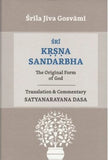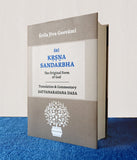SRI KRSNA SANDARBHA (The Original Form Of God)
The Jiva Institute of Vaiśnava Studies is happy to announce the publication and availability of the fourth book in the Ṣaṭ Sandarbha series, the Kṛṣṇa Sandarbha. Here we are providing an exclusive preview of this wonderful book by making the part of the introduction available:
| Vender | Rasbihari Lal & Sons |
The Jiva Institute of Vaiśnava Studies is happy to announce the publication and availability of the fourth book in the Ṣaṭ Sandarbha series, the Kṛṣṇa Sandarbha. Here we are providing an exclusive preview of this wonderful book by making the part of the introduction available:
Among the pantheon of Hindu gods, avatāras, and/or manifestations of Bhagavān, Śrī Kṛṣṇa stands out as one of the most popular and highly revered. Even among non-Hindus, He is widely acclaimed for His universal teachings on the path of enlightenment in the form of Bhagavad Gītā, the most renowned scripture of the Hindus, and for His fascinating life-stories. In spite of this extensive notoriety, His identity remains a great enigma. No other Hindu deity is shrouded in as much mystery as He. People from different backgrounds hold diverse opinions about Kṛṣṇa, many of which seem contradictory. They consider Him as a great lover, a skilled statesman, and a highly realized mystic. As an irrepressible lover, He is famous for stealing the clothes of the young gopīs while they were bathing in the Yamunā River and for marrying 16,108 princesses. Yet, as an accomplished mystic, He is esteemed as the speaker of Bhagavad Gītā and as Yogeśvara, the “Master of Yoga,” in which celibacy and reticence are fundamental principles. He is well-known as a simple cowherder, yet He is also famous as the most venerated royal scion, who received the principal honors at Emperor Yudhiṣṭhira’s Rājasūya yajña, in the presence of the world’s foremost kings, scholars, and sages.Notwithstanding Kṛṣṇa’s enigmatic nature, it is essential to gain a clear picture of His true ontological status in order to grasp the significance of the Bhāgavata Purāṇa and the method by which it self-discloses truth, namely, bhakti-yoga. As established in Tattva Sandarbha (Anucchedas 50–52) with reference to the Bhāgavata’s second verse (SB 1.1.2), this Purāṇa specifically propounds the supreme dharma of humanity, which is love for Bhagavān—our very source and refuge. To be infused with transcendental love for Bhagavān, authentic and unambiguous knowledge about Him and His essential being is of utmost importance. Since Bhagavān has innumerable forms, such as Viṣṇu, Rāma, Kṛṣṇa, and Nṛsiṁha, the question must be asked, are They all equiprimordial in their constitutional status or is there some hierarchy of being among Them? To address this question, Śrī Jīva Gosvāmī wrote this book, Kṛṣṇa Sandarbha.
The conventional and for the most part unexamined point of view is that Kṛṣṇa is simply an avatāraof Viṣṇu. In Kṛṣṇa Sandarbha, Śrī Jīva Gosvāmī uproots this misconception, demonstrating that Bhagavān Viṣṇu, being ontologically related to the play of creation and hence to immanence, is Himself implicitly included within a more complete transcendent Whole (avatārī), technically known as Svayaṁ Bhagavān, who is clearly identified in the text as Śrī Kṛṣṇa. Although Śrī Jīva previously delineated the ontology of Bhagavān in general terms in Bhagavat Sandarbha, he did not address the question of the identity of Svayaṁ Bhagavān Himself, or Bhagavān in His ownmost essential being, nature, and original form. In this respect, Kṛṣṇa’s status in regard to the various avatāras was not yet made a subject of inquiry. By first establishing a comprehensive universal understanding of Bhagavān in Bhagavat Sandarbha, Jīva Gosvāmī laid the foundation for a detailed investigation into the ontology of Svayaṁ Bhagavān in Kṛṣṇa Sandarbha. His fundamental conclusion in the latter volume is that Kṛṣṇa is the source of all other avatāras of Bhagavān and that He has no source other than Himself.
Jīva Gosvāmī’s primary intention in writing this book is to reveal Kṛṣṇa as the supreme object of worship and love. In the very beginning of Tattva Sandarbha, he clearly stipulated that the subject of the Six Sandarbhas is meant specifically for those whose sole aspiration is to be immersed in the bhajana of Śrī Kṛṣṇa. He even declared that the Sandarbhas should be studied only by such devotees. The present Sandarbha is surely in line with this declaration. In order for a devotee to be rightly established in such bhajana, he must have a clear understanding of the true nature of his object of worship. In Kṛṣṇa Sandarbha, Śrī Jīva Gosvāmī provides this distinct and esoteric knowledge of Kṛṣṇa, the supreme worshipable deity.
This book is truly a work of genius. No other book in or related to its field of study can compare to it. There have been many essays or short treatises written about Kṛṣṇa, but no one else has afforded this subject such a thorough and systematic treatment. Śrī Jīva Gosvāmī traces out Kṛṣṇa’s factual status among all the avatāras of Bhagavān based upon his careful study of Bhāgavata Purāna. Not only does he demonstrate that Kṛṣṇa is the original form of God, Svayaṁ Bhagavān, he goes a step further to establish a hierarchy within Kṛṣṇa’s own multifaceted manifestations. In this respect, he discloses that Kṛṣṇa as a cowherder and lover in Vraja is superior to His manifestation as a royal statesman in Mathurā and Dvārakā. This fact is so abstruse that even among Vaiṣṇavas, there are some who have difficulty in comprehending and accepting it. This precise realization, however, is crucial for the practice of rāgānugā-bhakti, or pure devotion in the wake of natural affection, which is the subject of the next book in this series, Bhakti Sandarbha. Kṛṣṇa Sandarbha is therefore the most important of all the ontological writings in the Gauḍīya Vaiṣṇava School, because it unravels the mystery regarding the Gauḍīya Vaiṣṇava’s worshipable deity, which gives the school its unique identity.Kṛṣṇa Sandarbha is the fourth book in the series of the Six Sandarbhas. Śrī Jīva Gosvāmī wrote the first three Sandarbhas—Tattva, Bhagavat, and Paramātma—based on the Bhāgavata Purāṇa’sfamous “vadanti” verse (SB 1.2.11). In these three books, he elaborated on the key words mentioned in this verse: tattva, brahma, paramātmā, and bhagavān. While treating their own graded thematic subjects, these first three Sandarbhas ultimately serve as an introduction to the fourth volume, Kṛṣṇa Sandarbha, in which Śrī Jīva Gosvāmī ascertains the identity of the original form of Bhagavān. In doing so, he brings to light the true significance of another key phrase from the vadanti verse—namely, that ultimate reality (tattva) is nondual consciousness (advaya-jñāna). Śrī Jīva conclusively establishes that this phrase is a reference to Śrī Kṛṣṇa, the Nondual Personal Absolute replete with His own interiority.





